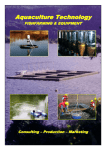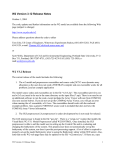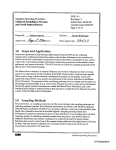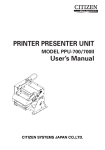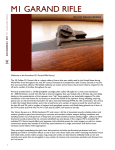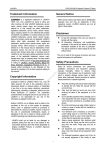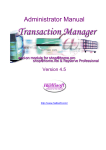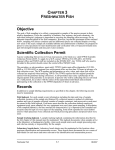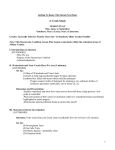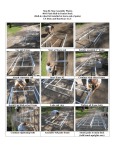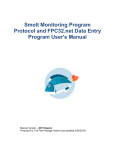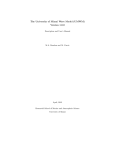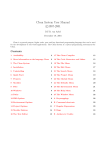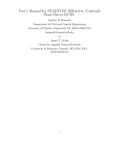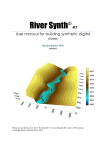Download Urban River Fish Community Monitoring Training Manual
Transcript
URBAN RIVER FISH COMMUNITY MONITORING TRAINING MANUAL FISH COMMUNITY MONITORING TECHNIQUES FOR VOLUNTEER MONITORS IN URBAN RIVERS Wood-Pawcatuck Watershed Association, Woonasquatucket River Watershed Council and the Narragansett Bay Estuary Program November 2013 URBAN RIVER FISH COMMUNITY MONITORING TRAINING MANUAL 2013 Disclaimer Under no circumstances will the Wood-Pawcatuck Watershed Association, Woonasquatucket River Watershed Council, Narragansett Bay Estuary Program, or the United States Environmental Protection Agency accept responsibility for any kind of problems arising from the use of the protocol. Health and safety issues relating to electrofishing are entirely the responsibility of parties who are intending to use or who are using the protocol. Users should bear in mind that electrofishing is a strenuous and potentially dangerous activity. It is the responsibility of parties using or intending to use the protocol to understand the potential dangers and to establish procedures to minimize risks. Under no circumstances will the Wood-Pawcatuck Watershed Association, Woonasquatucket River Watershed Council, Narragansett Bay Estuary Program, or the United States Environmental Protection Agency be held responsible for death or any form of injury, damage or loss occurring during or as a result of the use of the protocol. In addition to the risks associated with electrofishing per se, personnel working in the vicinity of rivers should be aware of Lyme Disease and other potential hazards and the steps to take to minimize the risk of exposure (see Appendix A). Acknowledgements Portions of this document were adopted from the electrofishing training manual used by the Scottish Environment Agency and from the US EPA Division 4 Science and Ecosystem Support Division Fish Field Sampling Operating Procedures. Many thanks to the Rhode Island Division of Fish and Wildlife Division for their guidance and help with this project. URBAN RIVER FISH COMMUNITY MONITORING TRAINING MANUAL 2013 Table of Contents 1.0 Introduction ......................................................................................................................... 1 1.1 Background, Scope and Application................................................................................. 1 2.0 How Electrofishing Works .................................................................................................... 1 2.1 Overview of Electricity ..................................................................................................... 1 2.1.1 Conductivity ......................................................................................................... 1 2.1.2 Current flow ......................................................................................................... 1 2.1.3 Electric potential .................................................................................................. 1 2.2 Types of Electrical Current ............................................................................................... 2 2.2.1 Direct current ....................................................................................................... 2 2.2.2 Alternating current .............................................................................................. 2 2.2.3 Currents for electrofishing ................................................................................... 2 2.3 Circuits .............................................................................................................................. 2 2.4 Electrical Pathways in Water............................................................................................ 3 2.5 Action of electricity on fish .............................................................................................. 3 2.5.1 Reactions to smooth direct current ..................................................................... 5 2.5.2 Reactions to pulsed direct current ...................................................................... 6 2.6 How can electrofishing operations/equipment damage fish .......................................... 7 2.6.1 Electrical damage ................................................................................................. 7 2.6.2 Non-electrical damage ......................................................................................... 7 3.0 Factors Affecting Fish Response .......................................................................................... 7 3.1 Water Conductivity .......................................................................................................... 7 3.2 Electrode Configuration ................................................................................................... 8 3.3 Current Type..................................................................................................................... 9 3.4 Stream Morphology ......................................................................................................... 9 3.5 Temperature .................................................................................................................... 9 3.6 Fish Species and Size ...................................................................................................... 10 3.7 Visibility .......................................................................................................................... 10 4.0 How to complete a fish community survey ....................................................................... 10 4.1 Required Electrofishing Team ........................................................................................ 10 4.2 Prior to going into the Field ........................................................................................... 11 4.2.1 Fish Community Monitoring Equipment ........................................................... 11 4.2.2 Electrofishing backpack ..................................................................................... 11 4.2.3 Electrofishing and the Weather ......................................................................... 12 4.3 In the field ...................................................................................................................... 13 4.3.1 Site Safety Meeting ............................................................................................ 13 URBAN RIVER FISH COMMUNITY MONITORING TRAINING MANUAL 2013 4.3.2 Checking of electrofishing backpack .................................................................. 13 4.3.3 Site set-up .......................................................................................................... 14 4.3.4 Electrofishing ..................................................................................................... 15 4.3.5 Fish holding and stress ....................................................................................... 17 4.3.6 Fish identification............................................................................................... 18 4.3.7 Additional data collection .................................................................................. 18 4.3.8 After sampling is complete ................................................................................ 20 5.0 Human Health and Safety .................................................................................................. 20 5.1 Overview of Health and Safety ...................................................................................... 20 5.1.1 Overall fitness .................................................................................................... 20 5.1.2 Electric shock ..................................................................................................... 20 5.1.3 Drowning ............................................................................................................ 20 5.1.4 Fire ..................................................................................................................... 20 5.2 Training ........................................................................................................................... 21 5.3 Personal Protective Equipment...................................................................................... 21 5.3.1 Clothing .............................................................................................................. 21 5.3.2 Boots and chest waders ..................................................................................... 21 5.4 Electrical Equipment ...................................................................................................... 21 5.5 Emergency and Accident Procedure .............................................................................. 22 6.0 References ......................................................................................................................... 23 Table of Figure Figure 1 - Simple circuit (left) and electrofishing circuit (right) ...................................................... 2 Figure 2 - Typical components of electrofishing equipment .......................................................... 3 Figure 3 - Constant voltage lines around an anode ring. ................................................................ 4 Figure 4 - Voltage across a fish ....................................................................................................... 5 Figure 5 - Current passed between two electrodes at constant voltage with increasing conductivity..................................................................................................................................... 8 Figure 6 - Movement of a single anode across and up a small river ............................................ 16 Figure 7 - In-stream positions of volunteers netting and electrofisher ....................................... 16 Table of Tables Table 1 - Pulse frequencies for different fish species based on the optimum combinations of attraction, immobilisation and welfare. ......................................................................................... 9 Appendices Appendix A – Additional Health and Safety Information Appendix B - Temperature, pH and Dissolved Oxygen Monitoring SOPs Appendix C – Site Maps Appendix D – Data Sheets URBAN RIVER FISH COMMUNITY MONITORING TRAINING MANUAL 1.0 2013 Introduction 1.1 Background, Scope and Application This document provides general procedures, methods and safety considerations applicable to collecting fish in freshwater wadeable streams using backpack electrofishing. This document is written for use by volunteer monitoring groups and specifies specific requirements for the Rhode Island Urban Fish Community Monitoring Project, a program of the Wood-Pawcatuck Watershed Association, Woonasquatucket River Watershed Council and Narragansett Bay Estuary Program. 2.0 How Electrofishing Works Electrofishing creates an electric field in the water which fish respond to by either some form of forced swimming and/or immobilization, thus rendering them easier to capture. As electricity in water is an unseen force it is not the easiest of subjects to understand, but a good understanding is necessary if optimum and safe use is to be made of the equipment. 2.1 Overview of Electricity Electricity is a form of energy and can be used for performing a task such as running lights, turning an electric motor or, in the case of electrofishing, producing an electric field in water. 2.1.1 Conductivity Materials that pass electricity are known as conductors, and materials that will not, insulators. Conductivity refers to the ease with which electricity passes through a conductor and is measured in micro-siemens per centimeter (μS/cm). In terms of water, it is the quantity and type of dissolved substances that determine conductivity. For example, water running off insoluble bedrock will have low conductivity whereas rivers draining fertile soils will have high conductivity. Road runoff in urban areas, especially if it includes road salts, will also have high conductivity. 2.1.2 Current flow Electric current flows through a conductor when there is a movement of free electrons through it. The amount of current flow is measured in amperes (amps). 2.1.3 Electric potential An electric potential is analogous to height. Just as a waterfall has to descend from a high to a low height, so too does electric current flows from a point of high electric potential to one of low electric potential, when the two are connected via a conductor. The difference between two points is known as the potential difference and influences the amount of current that will flow. The measurement unit for electric potential is the Volt and the total value is referred to as the voltage. 1 URBAN RIVER FISH COMMUNITY MONITORING TRAINING MANUAL 2013 2.2 Types of Electrical Current Two basic types of electricity are encountered: direct current and alternating current. 2.2.1 Direct current Direct current (DC) always flows in the same direction, and enables positive and negative outputs of a power source to be identified. When the flow is continuous it is known as smooth direct current (SDC). If the direct current is only allowed to pass in short bursts rather than continuously it is known as pulsed direct current (PDC) and the number of pulses per second is the frequency. Electrofishing uses pulsed direct current. 2.2.2 Alternating current Alternating current (AC) flows in one direction until it reaches a maximum, then decreases and reaches a maximum in the opposite direction. This cycle is repeated many times a second (usually 60) and the outputs of the power source effectively change over from positive to negative with each cycle. The power in your house is alternating current. 2.2.3 Currents for electrofishing Pulsed direct current is used for electrofishing. Alternating current can result in high fish mortality, does not attract fish from cover and also tends to be a greater health and safety hazard than direct current. Consequently alternating current should not be used for electrofishing and will not be covered in the remainder of this document. The simplest way to produce pulsed direct current necessary for electrofishing is to modify the alternating current. 2.3 Circuits In order to make use of electricity, a circuit is required. In normal circuits in air, great care is taken to ensure that the electricity is confined by insulated wires and cannot escape to where it is unwanted. A simple circuit could be an electrical generator and a load, such as an electric fire (figure 1, left). In electrofishing, only part of the circuit is confined by wire, the remainder of the circuit being the diffuse water path (figure 1, right). Contact with the water is made by means of conductive electrodes. Figure 1 - Simple circuit (left) and electrofishing circuit (right) 2 URBAN RIVER FISH COMMUNITY MONITORING TRAINING MANUAL 2013 The power source for electrofishing comprises both a portable generator (either batteries or engine) and a control box. Two electrodes are needed as a minimum to complete the circuit. When using the system in direct current mode the positive electrode is hand-held and known as the anode. The negative electrode, the cathode, is physically different and is often a metal plate or braided copper strip (figure 2). Figure 2 - Typical components of electrofishing equipment 2.4 Electrical Pathways in Water When electric current flows from an electrode into a body of water, it spreads out to occupy much of the available volume in a way analogous to that of magnetic field lines surrounding a bar magnet. The lines of current flow leave one electrode from all surfaces (but are concentrated at sharp corners) and radiate out into the water before converging and flowing back into the other electrode. The amount of electric current flowing from one electrode to another is independent on the distance they are apart. 2.5 Action of electricity on fish An electric current will flow through a fish if a detectable potential difference exists between one end of it and the other, and the larger the voltage the greater the current flow. If the voltage is measured for increasing distances away from an anode, it is seen to drop (figure 3). When fish are exposed to electric current, the further the fish is from the anode, the less voltage it experiences (figure 4). In the illustrated example, the furthest fish experiences a potential 3 URBAN RIVER FISH COMMUNITY MONITORING TRAINING MANUAL 2013 difference of 4 Volts and the nearest one, 50 Volts. There is consequently a zone around the anode which can affect the fish and outside of which the voltage is not sufficient to stimulate the fish. This zone is known as the sphere of influence or the effective electrofishing range. As a fish gets nearer to an electrode and the amount of current flowing through it increases, there are distinct changes in behavior. All reactions result from inducing electrical stimulation of the fish's nervous system, which at its simplest can be broken down into sensory nerve paths, brain nerve paths and motor nerve paths. Fish reaction to electricity depends on both the current type and the fish starting position in relation to the hand-held electrode. There are two current types to be considered, namely smooth direct current and pulsed direct current, and three fish starting positions relative to the electricity: facing towards, away from and sideways on to the anode. Figure 3 - Constant voltage lines around an anode ring. 4 URBAN RIVER FISH COMMUNITY MONITORING TRAINING MANUAL 2013 Figure 4 - Voltage across a fish 2.5.1 Reactions to smooth direct current Fish facing towards the anode: When the fish is initially facing the anode, fish behavior falls into 6 major categories. Relative to increasing current flow (i.e. as the fish gets nearer to the electrode) there is indifference, inhibited swimming, forced swimming, narcosis, pseudo-forced swimming and tetanus. These behavior patterns occur in concentric zones around the anode. The outermost zone of indifference is where current flow is inadequate for stimulation of the fish's nervous system. Inhibited swimming is the result of current flow through the fish which, although not enough to stimulate the sensory nerves, blocks the brain message that would normally give a swimming command. This reaction in essence prevents a fish from escaping once it is in the electrical sphere of influence. Assuming the anode is then moved closer to the fish, forced swimming toward the anode results from stimulation of the sensory nerves which, by reflex through the brain, send a swimming command down the motor nerve pathway. This action brings the fish into the narcosis zone where, in a similar way to the blocking of the fish’s own brain command, the reflex message is now blocked and forced swimming ceases. By using special electrodes in a tank and adjusting current flow through fish to be equivalent to this zone, electrical narcosis can be used to facilitate tagging, instead of using chemical anesthetics. In the field, the narcosis zone may not be observed, as the momentum of the fish carries it through into the pseudo-forced swimming zone. Alternatively, as is likely in fast flowing water, the fish is washed back to where forced swimming recommences and the cycle is repeated until the fish tires and is lost. With the fish even closer to the anode, pseudo-forced swimming is induced by the electrical current now being powerful enough to stimulate the swimming muscles via a spinal reflex from 5 URBAN RIVER FISH COMMUNITY MONITORING TRAINING MANUAL 2013 the sensory nerves through to the motor nerves. As the brain is no longer involved in the electrical pathway the fish is seen to be unbalanced during pseudo-forced swimming. Very close to the anode, the motor nerves are excited directly and to a degree where muscle cramp (tetanus) sets in and the fish keels over. Fish facing away from the anode: When the fish is initially facing away from the anode (and thus toward the cathode), four major reactions can be identified in the zones around the anode as the fish gets nearer and current flow through the fish increases. They are indifference, spasmodic swimming, half turn to the anode and tetanus. Indifference is replaced by spasmodic swimming as the anode is moved closer, with motor nerves becoming stimulated directly. It is at this stage that a fish can be lost as it can easily swim back into the indifference zone whereupon it will usually flee. It is therefore vital, when the fish is initially facing away, to bring the anode close enough for the fish to experience sufficient current to induce the reaction of half-turn to the anode. This is brought about by electrical stimulation of the most anterior sensory nerves which by brain reflex causes motor nerve commands of such a nature that the fish swims round to face the anode. Once the turn is complete, fish behavior becomes similar to the final stages already described. Tetanus sets in by the same mechanism. Fish sideways on to the anode: When the fish is initially sideways on to the anode, the potential difference is across the fish and not along it. Therefore the fish has to be much closer to the anode to have sufficient current pass through it to induce a reaction. This occurs in a position corresponding to just outside the tetanus zone and only one behavior pattern is observed. The motor nerves on the positive side of the fish are stimulated directly, causing muscles on that side to contract and the fish bends toward the anode, a process known as anodic curvature. 2.5.2 Reactions to pulsed direct current With pulsed direct current, when fish are initially facing away from or sideways to the anode, behavior is substantially the same as described above for smooth direct current. However, for fish facing the anode there is poorer stimulation of forced swimming and a greater degree of narcosis and tetanus. As a result, pulsed direct current can be more injurious to fish than smooth direct current. 6 URBAN RIVER FISH COMMUNITY MONITORING TRAINING MANUAL 2.6 2013 How can electrofishing operations/equipment damage fish 2.6.1 Electrical damage Electrofishing, when carried out properly, does not kill or permanently injure fish. However, if the electric field is too intense, or of an unsuitable type, or the fish’s exposure time to the electric current is too long, then paralysis can follow tetanus. This results from total physiological exhaustion of the nervous connections and pathways within the fish, or physical damage to the fish, and should be avoided at all costs. Fishing using direct current tires the fish the least and alternating current the most. This is reflected in the recovery times, and risk of injury to the fish, which increases from smooth direct current to pulsed direct current to alternating current. If a fish comes close to an electrode a semi-permanent discoloration, which looks like a burn or brand, can result on the body. This may be due to direct contact with the electrode or melanophore (pigment cell) dilation in response to nerve damage. Whilst the external branding will disappear, it is often associated with spinal injuries or hemorrhages under the skin. Internal damage may be present in the absence of external signs (Snyder, 2003). Broken backs or spinal damage may also be an occasional problem if the intensity of the electric current is too great or if spikes of excess voltage occur, as this can cause the swimming muscles on both sides of the spine to contract at the same time. Such damage can be minimized through preferential use of smooth direct current, using the lowest effective power setting, avoiding switching the power on and off when fish are near the anode, and by minimizing the exposure time through efficient hand netting of the fish. 2.6.2 Non-electrical damage During electrofishing operations, fish can also be damaged by factors not directly related to the electric current. These could include: trampling on stunned fish by persons conducting electrofishing operations, poor netting practice causing damage to fish by banging and squashing, chemical damage caused by over-anaesthetizing fish or a spill of another chemical into the holding bucket and asphyxiation of fish through overcrowding or overheating of the water in the holding buckets. Damage and disturbance can also be caused to other species sharing the same environment, for example, trampling on freshwater mussels or disturbing birds and otters. 3.0 Factors Affecting Fish Response 3.1 Water Conductivity By far the most important factor in electrofishing is the conductivity of the water. When looking at current between two electrodes at a constant voltage, as conductivity increases so does the amount of current flow (figure 5). This means that in higher conductivity water (saltier 7 URBAN RIVER FISH COMMUNITY MONITORING TRAINING MANUAL 2013 water) there is a higher demand on the power source to maintain a set voltage than for the same voltage in low conductivity (less salty) waters. Figure 5 - Current passed between two electrodes at constant voltage with increasing conductivity. 3.2 Electrode Configuration For any given conductivity, electrode size affects the size of the electrical sphere of influence. An electrode with a large surface area enables more current to flow into the water than does one with a small surface area and it forms a larger electrical field which is less intense close to the electrode surface. Using too small an electrode produces an intense field with high potential gradients which can cause dangerous tetanus effects. Therefore it is desirable to use the largest possible electrode array that stream width and morphology allow, and that available voltage and power allow. Additionally, often the only way of establishing a reasonable fishing distance in waters of very low conductivity (and hence light electrical load) is to use an electrode of very large surface area to introduce sufficient current into the water to motivate the fish. However, these large electrodes require high voltages in low conductivity waters and generators are often required to supply the power demands. It should be remembered that, whether single or multiple anodes are being used, the cathode should have a surface area several times the total effective anode surface area. By using a larger cathode than anode the resistance to current flow at the cathode is reduced. This concentrates most of the available voltage at the anode, making more power for fishing potentially available at the anode. 8 URBAN RIVER FISH COMMUNITY MONITORING TRAINING MANUAL 2013 3.3 Current Type Smooth direct current has the lowest tetanising effect, therefore resulting in less injury to fish. It also is better at stimulating fish to swim towards the anode and has the ability to attract fish from hiding places. However the higher power demand to provide smooth direct current compared to pulsed direct current may limit its use, for instance in high conductivity waters, unless a large generator can be used. Pulsed direct current can be used in these situations where smooth direct current is not effective, as fish tend to exhibit a greater reaction to pulsed direct current compared to the same voltage of smooth direct current and the power demand is lower. Different species of fish react preferentially to different numbers of pulses per second. Table 1 below details the optimum pulse frequencies for a variety of fish based on Beaumont et al. (2002). However not all electric fishing equipment will allow such a precise degree of frequency control. Pulse frequencies should be kept as low as possible whilst allowing effective fishing. Table 1 - Pulse frequencies for different fish species based on the optimum combinations of attraction, immobilization and welfare. Species Salmonids Cyprininds Percids Pike Eels Pulse frequency (Hz) 40-60 30-50 10-40 30-50 10-40 3.4 Stream Morphology In large water bodies where the habitat is poor or very uniform and does not restrict fish movement, fish are more likely to escape from the general disturbance and not come into working range. In general terms, therefore, effective electrofishing is more easily achieved in smaller rivers and streams. Stream morphology also has an impact on electrofishing efficiency by affecting current flow. The electric field is often distorted in shallow water, which allows more effective fishing. In deeper water, where the current lines are more dispersed, power requirements to maintain a given voltage are higher. In high conductivity waters, small generators can sometimes stop working in such situations particularly when smooth direct current is in use. 3.5 Temperature Fish metabolism is modified by water temperature and consequently fish response to an electric field can change. Fish excitability is increased in very warm water and reactions are reduced in very cold water. In practice this means that in both extreme situations fish become difficult to catch. In addition, fish in warm water are more easily stressed by all the associated 9 URBAN RIVER FISH COMMUNITY MONITORING TRAINING MANUAL 2013 handling. For salmonids the best fishing temperatures are l0-l5°C (50-59°F) and for cyprinids, 10-20°C (50-68°F). 3.6 Fish Species and Size The lifestyle of the species can modify its response to an electrical field. Salmonid fish are better swimmers than many coarse fish and will therefore swim both more rapidly and for a longer time before becoming exhausted. Bottom living fish such as the bullhead may show a tendency to be immobilized in situ underneath stones on the riverbed. Eels in open water will react by swimming forward but one in hiding can react by moving farther back. Shoaling fish species will be more likely to flee than territorial species. Large fish show a greater reaction to electrofishing than small ones do. The bigger a fish is, the more constant voltage lines it can span, and the higher the potential difference it experiences between head and tail. If it is anticipated that large fish will be encountered, for example during broodstock collection, the voltage must be reduced to the minimum required to attract them. If the large voltages typically employed for juvenile surveys are employed for large fish then injury may occur. 3.7 Visibility Irrespective of all other factors, if the operator cannot see to retrieve fish then efficiency is bound to suffer. Major problem areas are waters having high turbidity, wind action, rain or excessive weed growth. The general rule of thumb is that you must be able to see the stream bed; otherwise stunned fish may be left behind, resulting in their injury and /or failure to catch them. 4.0 How to complete a fish community survey Surveyors must work as a team and employ a method that is suitable for the prevailing environmental conditions for an electrofishing survey to produce meaningful results. 4.1 Required Electrofishing Team Each electrofishing team will consist, at a minimum, of one team leader and five other volunteers. Three to five people in the water is optimal to conduct a survey in wadeable streams. In addition, several people may help on the shore with buckets and data collection. The size of the crew will depends on the size of the stream and the equipment needed. No-one should ever electrofish alone. An experienced team leader must be appointed to every team of operators and should have on-site responsibility for safety, first aid and for the equipment and protective clothing. However, every member of the team has a responsibility to work in a safe manner and to inform the leader of any deficiencies. 10 URBAN RIVER FISH COMMUNITY MONITORING TRAINING MANUAL 4.2 2013 Prior to going into the Field Prior to completing a field effort, all required equipment should be checked and collected. The field team leader must check the equipment, paying particular attention to the electrofishing generator, electrical control gear and cable insulation. No electrical repairs can be carried out on site. The weather forecast should be checked as weather affects electrofishing process. 4.2.1 Fish Community Monitoring Equipment Required equipment: Electrofishing backpack, which includes a battery power source, control box, an anode and a cathode. Rubber linesman’s gloves/electrical rated gloves for each person in the water. Waders with rubber soles for each person in the water. 2 to 3 buckets. Hand nets with non-conductive handles (use knotless mesh for fish welfare). First aid kit. Dissolved oxygen test kit, pH test kit, thermometer and small plastic bottle for temperature and pH sample. Nitrile gloves and safety goggles for dissolved oxygen assay. Data sheets. Fish identification references. Fish box with centimeter ruler to measure fish. Digital camera and laminated numbers for placement in the photograph to track fish photographs. Bug spray, sunscreen, water and other personal items. Polarized glasses, yellow preferred. Cell phones. 100 foot measuring tape. Yard ruler for measuring stream depth. Emergency contact information for each team member. 4.2.2 Electrofishing backpack The backpack equipment power source is derived from a battery, usually combined in the same housing structure as the control box. The control box has two distinct functions: first, to provide a safety feature that can be used to stop the supply of power to the electrodes, and second, to modify the electrical output to the anodes. Control boxes will comprise the following control features: power on/off switch, emergency stop button, method for setting the type of electrical output, voltmeter and method for changing the level of voltage and amp meter. The anode is hand-held with the live electrical surface at the end of a long insulating tube. The anode is controlled through the use of a low voltage deadman’s switch, operating from an 11 URBAN RIVER FISH COMMUNITY MONITORING TRAINING MANUAL 2013 electrically independent circuit switch. This switch needs to be consciously depressed for power to flow from the control box to the end of the anode. The cathode is a braided metal strip or plate that is placed in the water and connected to the control box via an insulated wire. Maintenance of electrofishing equipment The electrofishing backpack will be maintained by the Woonasquatucket River Watershed Council as specified in the user’s manual. 4.2.3 Electrofishing and the Weather Ideally, when electrofishing, the weather would be dry, calm, and not too sunny or warm, so that water levels are at a manageable height for electrofishing and the water stays at a suitable temperature for the fish. However, long periods of weather like this are very rare in New England and, during the summer when electrofishing usually takes place, you can be faced with variable conditions. Here are some things to look out for in terms of the weather and electrofishing: Rain: Rain increases the risk of an electric shock from the equipment and reduces the efficiency of electrofishing as the rain disturbs the surface of the water and fish become less visible. Electrofishing will not be carried out during periods of rain. If in the field and it starts to rain, stop operations immediately and wait for the rain to pass or come back another day. Wind: Wind increases the chance of tripping as the operator may be knocked off balance or be unable to see their feet when standing in the water. Wind also reduces the efficiency of electrofishing as the wind ripples and disturbs the water surface and fish become less visible. Small fish may also get blown out of nets, particularly if the net is held at an inappropriate angle to the wind. Stop electrofishing when visibility of the surface of the stream is reduced. Lightning: Thunderstorms can present especially dangerous conditions due to the accompanying lightning. Lightning can cause fatal or debilitating injuries through direct and indirect strikes, especially to members of the team in the water. It can damage any electrical equipment as well. Lightning can strike as far as 5 miles in front of a storm and during the entire duration of a storm. The team should take extreme caution when thunderstorms are predicted and should not to be in the water at least one half hour before a storm may strike the survey area and no one should return to the water for at least one half hour after the storm has passed. If thunderstorms are predicted, it is prudent to postpone the survey to another day. If thunderstorms develop in the survey area during a survey the team should stop immediately and leave the site. 12 URBAN RIVER FISH COMMUNITY MONITORING TRAINING MANUAL 2013 4.3 In the field 4.3.1 Site Safety Meeting Prior to starting the survey, before any site set-up begins, a site safety meeting should be completed. Attendance at the meeting should be recorded in the field notebook. The following items must be discussed: Identify the team leader. Identify the persons trained in CPR/First Aide as well as the location of the first aid kit. Discuss the work to be done and the tasks each person will perform. Identify safety issues and potential site hazards. A clear system of working signals should be laid down before operations begin and followed by all members of the team. Obtain emergency contact information for each team member. The following safety procedures must be discussed: Unprotected parts of the body must not be put in the water when electrofishing equipment is operating. All persons in the water must wear waders and electrical rated gloves. Any metallic part of an electrode must not be touched unless it is physically disconnected from the electricity supply. Nothing should be taken from the electrode by hand; fish and debris should be transferred to a non-conductive container before being handled. Whenever the equipment is operating, the electrodes should be treated as being live, even when safety switches are known to be off. Electrodes must not be left unattended when connected to a live power source. Under no circumstances should the electrode head be allowed to leave the water before the safety control circuit switch is released. Electrode rings must not be used as dip nets. The equipment operation manual for each type of fishing gear must be made available to all personnel involved with its use. All personnel should have reviewed Section 5.0 of this document. Spectators Where fishing activity is likely to attract spectators, temporary warning signs should be erected to indicate ‘Danger, electrofishing in progress’. Spectators should be warned to keep away from the water and equipment. Animals must also be kept away. Fishing must stop if persons or animals come within three feet of the electrodes. 4.3.2 Checking of electrofishing backpack Equipment should be re-checked on site when fully assembled and while electrically dead, paying particular attention to plugs and sockets to ensure that they are correctly fitted and 13 URBAN RIVER FISH COMMUNITY MONITORING TRAINING MANUAL 2013 seals fully tightened. Check the mechanical operation of safety switches before the equipment is energized. Any item of the equipment must not be used if any part of it appears not to be working. Specific checks spelled out in the user’s manual should be completed. If the result of the electrically dead examination is satisfactory, the generator should be started to prove the operation of the systems and safety switches with the electrodes immersed in water before actual fishing begins. Fishing electrodes must never be energized unless immersed in water. 4.3.3 Site set-up Prior to electrofishing a site, it is important to approach each sampling in a logical manner to ensure the welfare of the volunteers and any fish that are caught. The responsibility for the welfare of the team and fish falls to each member of the team. All members of the team should be aware of the reasons for the sampling and the particular tasks that they will be carrying out. The procedure is as follows: 1. On arrival at a river, the section of river to be surveyed should be identified prior to anyone entering the water. For this project, river sections will be pre-selected by staff and detailed on maps sent with the field teams. In general the staff will, select a portion of the stream that has constricting points upstream and downstream to keep fish from leaving the area to be surveyed. A constructing point could be a bend in the river or a shallow bar that will keep fish from fleeing the sampling site. A marker should be placed at the upstream and downstream portion of the site to be sampled. Use the measuring tape to determine this. a. Sites with stream width less than 10 feet, measure out a 100 foot stream length for sampling. b. Sites with stream width greater than 10 feet in width, measure out a 150 length of stream to sample. 2. Set-up fish holding equipment. Set up the buckets for holding fish outside of the area to be surveyed and not subject to the electric field. Ideally the holding buckets should be placed in the shade and covered to prevent excessive water temperatures or fish from escaping. Buckets should be filled with water from the area you are sampling. It is often necessary to have one person carry a bucket behind the team to facilitate quick transfer of fish. 3. Once the fish processing equipment has been set up, the electrofishing equipment should be checked to ensure the integrity of the equipment before it is switched on. See section 4.3.2. 4. Generators should be started and control units energized only when the electrodes are in the water and each team member has verbally acknowledged that they are ready for operation. 14 URBAN RIVER FISH COMMUNITY MONITORING TRAINING MANUAL 2013 5. Initially use the voltage settings saved in the electrofisher. Adjust settings as necessary based on recommendations in the user’s manual. 6. Complete one pass of the elctrofishing area using the procedure outlined below (Section 4.3.4). 4.3.4 Electrofishing In order to effectively electrofish a population of fish it is necessary to bring the fish under the influence of the electric field and to net and remove them from the water and out of the influence of the electrical current. Fish sampling always starts at the downstream end of the site so that the flow of water brings stunned fish towards the operator. Starting at the downstream end of the section being surveyed, the anode should be moved in order that all of the fish within the site have an equal chance of coming into contact with the electrical field. The method in which this is done is dependent upon the width and morphology of the river. The anode should be submerged at all times and held just below the surface of the water. This will help to draw fish up to the surface as they are attracted to the anode, rendering them easier to catch. The single anode should be moved up the river using a sweeping motion to ensure that all areas are covered (figure 6). Note that it is important to ensure that banks with draped vegetation or undercuts are surveyed as they often contain significant numbers of fish. An attempt should be made to survey all micro habitats. Sweeping the anode under the banks will help to draw fish out of hiding. If the flow in the river has become divided into a number of separate channels, each channel should be individually electrofished. The personnel holding the hand nets should follow the anode in such a manner that any fish attracted to the anode can be quickly scooped up and placed in a bucket (figure 7). Once caught in the hand net, fish should not be left in the water as they will still be within the electric field and subject to potential damage. If a large number of fish are encountered or the netter needs to pause to transfer fish, the power at the anode should be turned off until all personnel have verbally acknowledged that they are ready to continue. All personnel responsible for collecting and seeing fish in the water should wear polarized glasses to aid in seeing the fish. Yellow tinted polarized glasses are the most effective type for seeing fish. 15 URBAN RIVER FISH COMMUNITY MONITORING TRAINING MANUAL Figure 6 - Movement of a single anode across and up a small river Net #2 Stream Bank Net #1 Stream Flow Electrofisher Net #3 Figure 7 - In-stream positions of volunteers netting and electrofisher 16 2013 URBAN RIVER FISH COMMUNITY MONITORING TRAINING MANUAL 2013 4.3.5 Fish holding and stress Large and small fish can be held separately to prevent the water becoming rapidly deoxygenated, but for all sizes care should be taken to avoid holding too many fish in the same container. One member of the team should be responsible for observing the condition of fish being held. If the water temperature starts to rise excessively and fish start to show signs of stress due to lack of oxygen, remove some of the water from the bin by decanting using a bucket and replace with fresh cold water from the stream being sampled. Sections 2.5 and 2.6 provide information on the action of electricity on fish and the damage that can be caused by electrofishing, respectively. However, it is difficult to recognize normal signs of stress when fish are stunned as they are effectively anaesthetized. The fish can suffer from synaptic fatigue when over-exposed to a tetanising electric current. Usually, when this occurs, the fish does not recover immediately and dies because breathing is not re-established. Throughout the period that fish are retained in the holding units they should be regularly observed for signs of stress, especially those that could indicate that the fish are short of oxygen. Fish will show some signs of stress in holding bins or buckets anyway, because they are removed from their natural environment. Signs of stress to look for that could indicate low oxygen levels include: Hyperactivity in salmonids, although many coarse fish may become quiescent. Very fast movements of gill covers. Fish come to the surface and appear to gulp air. Fish start to keel over. Any unusual activity could be a sign of stress. Fish should be moving around slowly at the bottom of the bucket and breathing steadily at a normal rate. If you notice a fish is having difficulty or has not re-established breathing after being stunned, and its gill covers are not moving, it may be possible to resuscitate the fish by moving it backwards and forwards in the water, to pass water through the mouth and over the gills. This stimulates ventilation, starts the heart and starts breathing – the “water flow heart rate reflex”. Fish should be released once electrofishing and the associated in-stream measurements at the site have been completed. The fish should be showing signs of recovery – normal activity – and be maintaining their position and orientation constantly in the water column. Some species take longer to recover than others. If electrofishing has been conducted for survey purposes, the fish should be released into the same area from where they were captured, with no extreme changes in temperature. The fish should be spread out along the survey stretch in areas of calm flow near the bank. 17 URBAN RIVER FISH COMMUNITY MONITORING TRAINING MANUAL 2013 If the fish are showing signs that they are having difficulty recovering in the holding bins, they should be returned to the stream, once electrofishing has finished, and be allowed to recover there. Make sure that they are placed in a sheltered area with a low water flow so that they have time to recover and are not swept away with the current. At this stage the fish may also be more susceptible to predators, so allow fish to recover while you are still around the site and, by your presence, actually deterring predators from coming to the water. 4.3.6 Fish identification Once electrofishing is complete fish identification can begin. 1. Remove one fish at a time from the bucket and place on the ruler in the fish box. 2. Record the length in mm on the data sheet – Fish Length Frequency (Appendix D). 3. Record the species on the data sheet. Species identification can be made using the laminated fish illustrations. 4. Take a digital picture of the fish along with the appropriate laminated number for that day, if it is a species that has not been identified yet or you are unsure of the identification. For example, if the team selects a bluegill and it is the first bluegill and first species of the day, the bluegill photo will have the laminated number 1 in it. If a golden shiner is the next unique species of the day, the photo would have the laminated number 2 in it, etc. Be sure to note the digital photo number next to the data sheet record for the fish. 5. Place the fish in a bucket for return to the stream. 6. After identification of all the fish return all the fish to the stream and summarize number of fish by species using the last page on the data sheet – Fish Assemblage Data Form (Appendix D). 4.3.7 Additional data collection Once electrofishing is complete, collect the rest of the data required on the data form: 1. Record the following information on the data form (Appendix D) in the appropriate location : a. Date, time, weather conditions. b. Names of the field team members. c. Name of stream and location. d. Description: Sketch the reach you are sampling on the back of the field sheet. The sketch should include locations of riffles, pools and runs. e. Habitat type (%): riffle, pool, run. Estimate the percentage of each habitat type over the stream reach. The percentage should add to 100%. A riffle is an area of the stream with disturbed water, a pool is a deep section of the river and a run is a section of the stream with smooth flow with a depth that is generally nonchanging. 18 URBAN RIVER FISH COMMUNITY MONITORING TRAINING MANUAL 2013 f. Impediments: Determine if there are any impediments in the stream upstream or downstream of the sampling location. Circle yes or no, as appropriate. If there are impediments describe them (eg: sand bars, shallow sections, trees, etc.) g. Reach length: Circle the reach length that was sampled. For this project it will be 100 ft. h. Wetted width: Use the measuring tape to determine the wetted width of the stream. i. Maximum pool depth (inches): Use the yard stick or a ruler to determine the water depth in the deepest section of the sampling area to the nearest half inch. j. Shading by overhead canopy: Estimate the percent of the stream reach that is shaded if the sun were directly overhead and the vegetation were in full leaf-out. k. Substrate type: Estimate the substrate type in the reach, the total should add to 100%. l. Vegetation in the stream: Circle the appropriate descriptor (yes or no) corresponding to the presence of vegetation in the stream bottom (substrate). m. Vegetation type: Circle the types of vegetation growing in the stream, if any. Emergent vegetation is rooted in the stream bottom but the top of the plant either breaks the water surface (like a cattail) or is floating on it (like a lily pad). Submergent plants are growing on the bottom, with most of the plant mass living below the surface, but portions of the plant may stick out of the water. Floating plants are not rooted to the bottom but float on the surface. n. Percentage of bottom covered in vegetation: If there is vegetation, estimate the percentage of the bottom that is covered in vegetation. o. Silt coverage of the bottom substrate: Determine if silt is covering any of the bottom substrate and circle the appropriate descriptor (yes/no). Silt is a very fine sediment that will move when you disturb it, it will make the water cloudy as well. p. Percentage of bottom covered in silt: If silt is present, estimate the percentage of the bottom that is covered in silt. q. Water chemistry: Water temperature, pH and dissolved oxygen – Collect these readings just upstream of the fish sampling area at about the middle of the stream. Be sure to avoid stirring up the bottom, only collect the sample in an undisturbed area. i. Mark the sampling location on the site sketch. ii. Record the depth of the sampling location in inches on the data sheet. iii. Collect the water sample from mid-depth or an arm’s length depth, whichever is less. iv. Be sure to collect the temperature readings as soon as you retrieve the water sample. v. Specific instructions on how to collect temperature, pH and dissolved oxygen values are found in Appendix B. 19 URBAN RIVER FISH COMMUNITY MONITORING TRAINING MANUAL 2013 r. Comments - Add any additional comments on the site or how the field survey went on additional sheets. 4.3.8 After sampling is complete After the field effort is complete: 1. Rinse all field equipment (buckets, nets, boots, gloves, etc.) with freshwater and return to the Woonasquatucket River Watershed Council. The Council will allow equipment to completely air dry before using again. This is especially important to minimize the risk of transferring invasive species such as plants and mussels from site to site. 2. Give the data sheets and electronic copies of the photographs to your watershed group. 5.0 Human Health and Safety 5.1 Overview of Health and Safety 5.1.1 Overall fitness Electrofishing volunteers must be fit for the task that they are being asked to carry out. Volunteers should assess their own suitability for the task and only accept responsibility for tasks they feel they can reasonably complete. Electrofishing requires movement over uneven or slippery ground, moving and lifting of heavy buckets and associated equipment as well as exposure to the elements and environmental hazards such as poison ivy and ticks. Operators working where space is restricted should take care not to injure others when using landing nets, electrodes and poles. Drinking alcohol before or during electrofishing is not allowed. 5.1.2 Electric shock Electric shocks may themselves injure or kill, or may cause indirect injuries by making a worker recoil so that he/she endangers himself/herself and others by sudden movement. Direct effects include electrical burns, heart failure or interference with breathing. The main sources of potential risk of electric shock during electrofishing operations are: • Bodily contact with energized electrodes. • Bodily contact with water within the radius of the electric field. • Shocks from damaged, inadequately constructed or poorly insulated equipment. 5.1.3 Drowning When working on or near water there is always a risk of drowning. Electrofishing should not occur in swift currents or in streams deeper than the top of the thigh. 5.1.4 Fire Care should also be taken to ensure metal items do not come into contact with the electrofishing backpack battery terminals for example when they are being transported in rucksacks when not in use. A power shortage could cause fire. 20 URBAN RIVER FISH COMMUNITY MONITORING TRAINING MANUAL 2013 5.2 Training All volunteers are required to attend electrofishing training. Training will include: Discussion of environmental and safety hazards during electrofishing How the electrofishing process works Expectations for data collection Fish identification At least two members of each electrofishing team must be CPR and first aid certified. 5.3 Personal Protective Equipment 5.3.1 Clothing Clothing worn for electrofishing should be appropriate to the conditions and should not be so long as to trail in the water as this could introduce an electrical hazard from stray current paths. Clothing should not have buttons or buckles that could snag on cables and landing nets or have metallic zips that could conduct electricity. 5.3.2 Boots and chest waders Chest waders in good condition and made from non-conductive material are required. Studded boots are not recommended. Care must be taken in using chest waders as drowning is a concern. If the average depth of water is too deep for operators to wade at less than thigh depth for the majority of the fishing exercise, then the site is not suitable for sampling. Water deeper than the top of the thigh must never be waded. Please remember that felt soled boots and waders are not allowed in Rhode Island’s freshwaters as they can transfer invasive species from site to site. 5.4 Electrical Equipment All nets must be constructed with non-conducting handles. The electrofishing backpack must be mounted on a quick release harness to enable rapid removal from the person carrying it. The electrofishing control box must contain tilt and float switches, which interrupt the power input from the battery whenever the unit ceases to be carried less than 45° from upright or if the unit enters the water. These switches must operate electronic trips such that manual reset via the external button is required before the control box can be re-energized. All equipment must have accompanying operation and maintenance manuals which provide full descriptions of the equipment, performance specification, use of controls and safety instructions. Electrofishing equipment must be properly maintained and regularly checked for mechanical and electrical faults as specified in the user manual. These regular checks must be performed by suitably qualified personnel who must keep suitable records. To facilitate the keeping of 21 URBAN RIVER FISH COMMUNITY MONITORING TRAINING MANUAL 2013 records, equipment items should be individually identified. Safety checks carried out by operators must be considered as an addition to routine maintenance and not a substitute. 5.5 Emergency and Accident Procedure If there is an accident, immediately: 1 - Switch off the electrodes. 2 - Switch off the emergency stop button. 3 - Remove electrodes from the water. If qualified to do so, administer first aid. Any casualty who has been rendered unconscious must be examined by a doctor as soon as possible, even if he/she appears to have recovered. In the case of serious injury, call for an ambulance by the quickest available means as this is the fastest way of obtaining medical care. Where injuries are minor, apply first aid as necessary. Do not neglect minor burns, cuts and abrasions which should be cleansed and covered with a waterproof dressing. 22 URBAN RIVER FISH COMMUNITY MONITORING TRAINING MANUAL 6.0 2013 References Scottish Fisheries Co-ordination Centre, Inverness/Barony College. (June 2007). Introductory Electrofishing Training Manual, Fisheries Management SVQ Level 2: Catch Fish Using Electrofishing Techniques. Hartel, K. E., D. B. Halliwell, and A. E. Launer (2002). Inland Fishes of Massachusetts. Massachusetts Audubon Society. Lincoln, MA. Libby, A. (2013). Inland fishes of Rhode Island. Rhode Island Division of Fish and Wildlife. West Kingston, RI. Murphy, B. R. and D. W. Willis (1996). Fisheries Techniques. American Fisheries Society. Bethesda, MD. Page, L. M. and B. M. Burr (1991). A Field Guide to Freshwater Fishes. Houghton Mifflin Co. Boston, MA. Snyder, D.E. (2003). Electrofishing and its harmful effects on fish. USGS Information and Technology Report USGS/BRD/ITR—2003-0002. 149pp PDF file downloadable from www.fort.usgs.gov/products/publications/ United States Environmental Protection Agency (USEPA) (1999). Rapid Bioassessment Protocols for use in Streams and Wadeable Rivers: Periphyton, Benthic Macroinvertebrates, and Fish. Second Edition. EPA 841-B-99-002. Office of Water, Washington, DC. US EPA (2011). Operating Procedure Fish Field Sampling. Region 4 SESD, Athens, GA. 23 URBAN RIVER FISH COMMUNITY MONITORING TRAINING MANUAL 2013 APPENDIX A: Additional Health and Safety Information Lyme Disease is caused by the bacterium Borrelia burgdorferi and is transferred to humans by infected ticks. Care should be taken around forests and wetlands where the tick’s hosts, deer, are prevalent. Exposure to tick bites can be reduced by covering the arms and wearing long pants (light color show up the ticks most easily) or boots, and by checking your skin carefully at the end of the day. To remove a tick grip the tick as close to the skin as you can with tweezers and gently pull, twisting anti-clockwise at the same time. Specially designed loops for tick removal are often available from pet shops or veterinary surgeries. The first symptom to be aware of is usually a pink or red spot at the site of the tick bite. This may take 3-30 days to develop and expands steadily, often with an inflamed red border. As the rash spreads the inner skin may return to a more normal appearance, forming an expanding “target pattern” with a flat border, or it may remain more evenly colored. This rash, the “erythema migrans”, may become large (10-70 cm) if left untreated. Additional symptoms in the first few weeks are: tiredness / fatigue, headache, fever, aches in muscles and joints, stiff neck and swollen glands. In rare cases more serious complications affect the nervous system, joints, heart and other tissues. Anyone experiencing the erythema migrans rash should seek medical treatment. Diagnosis of Lyme Disease can be difficult, especially if you have been unaware of the tick bite, as the bacterium does not always trigger the production of antibodies against it as some forms do not have a cell wall and may fail to be recognized as “foreign”. Early treatment with antibiotics is usually recommended. URBAN RIVER FISH COMMUNITY MONITORING TRAINING MANUAL 2013 APPENDIX B: Temperature, pH and Dissolved Oxygen Monitoring SOPs URBAN RIVER FISH COMMUNITY MONITORING TRAINING MANUAL 2013 How to collect temperature, pH and dissolved oxygen samples (adopted from URI Watershed Watch Wadeable Stream Monitoring Manual, March 2012) 1. Go to the monitoring site, which is upstream of the fish sampling area. Be sure that the area is not disturbed. When you wade into the water, make sure you are facing upstream so that what you stir up by wading in doesn’t get into your bottles. 2. Rinse your small plastic bottle with surface water. This bottle will be used for collecting the temperature and pH samples. 3. Holding the empty plastic bottle upside down, lower it half way to the bottom or an arm’s length, whichever is less. Then quickly turn the bottle right side up and allow it to fill with water. When it is done filling, remove the bottle from the water and cap it. 4. Next take each of the two glass dissolved oxygen bottles. Repeat the sampling process for each bottle, one at a time. a. Remove the glass stopper. Then lower the bottle upside down to half way to the bottom or an arm’s length, whichever is less. Be sure not to stir up bottom sediments into your water sample. b. Turn the bottle right side up allow it to fill and then quickly raise it to the surface and put the glass stopper on the bottle. c. There should be no air bubbles in the dissolved oxygen bottles, if there are, dump out the water and collect the water sample again. 5. Use the yard stick or a ruler to record the depth you collected the water sample from, put that information on the data sheet. 6. Go back to shore and immediately put a thermometer into the plastic bottle. Take the temperature after about a minute and record the value on the field data sheet. 7. Next, start the dissolved oxygen test, following the instructions provided below. There should be a total of 4 dissolved oxygen values recorded. You will complete a replicate dissolved oxygen sample on each dissolved oxygen bottle. a. If the test results between the two tests run on the sample bottle are more than 1.0 mg/L different, run the test again and record all three values on the data sheet. 8. After the dissolved oxygen tests are done, complete the pH test on the water in the plastic bottle. Complete the test two times. Instructions are provided with the test kit (see below). Record your sample values on the field data sheet. a. The two pH values must be within 1 unit of each other, otherwise, run the sample a third time, making sure to record all your results on the data sheet. 9. After collecting all the needed data, rinse all the equipment with tap water and allow it to dry. URBAN RIVER FISH COMMUNITY MONITORING TRAINING MANUAL 2013 URBAN RIVER FISH COMMUNITY MONITORING TRAINING MANUAL 2013 Dissolved Oxygen Test Kit. Important notes: The most important first step is to be sure your dissolved oxygen bottle is filled to the brim and there are no air bobbles. It is very important to minimize contact of the water sample with air. o While the stream water sample will contain from 0 to 12 ppm oxygen, the air we breathe contains about 210,000 ppm of oxygen, so we don’t want to introduce any of the atmospheric oxygen into our water sample. Read the information ctonained in the Material Safety Data Sheets (MSDS) that come with each kit. Glasses or safety goggles and gloves should be worn because of the chemical reagents used. The dissolved oxygen kits must be kept out of the reach of children. Keep a supply of paper towells on hand to mop up any spills right away. After finishing with the kit, all the equipment must be carefully rinsed with tap water and allowed to air dry on a paper towell. The chemical reagents used in the analysis can be safely flushed down the drain with plenty of water or poured onto the ground. WASH YOUR HANDS THOROUGHLY WHEN YOU ARE DONE. If you spill any of the chemical reagents on yourself, immediately flush the affected area with lots of water. Its fine to use stream water. Do not wait to wash it off until you are at faucet. URBAN RIVER FISH COMMUNITY MONITORING TRAINING MANUAL 2013 URBAN RIVER FISH COMMUNITY MONITORING TRAINING MANUAL 2013 URBAN RIVER FISH COMMUNITY MONITORING TRAINING MANUAL 2013 URBAN RIVER FISH COMMUNITY MONITORING TRAINING MANUAL 2013 URBAN RIVER FISH COMMUNITY MONITORING TRAINING MANUAL 2013 URBAN RIVER FISH COMMUNITY MONITORING TRAINING MANUAL 2013 URBAN RIVER FISH COMMUNITY MONITORING TRAINING MANUAL 2013 URBAN RIVER FISH COMMUNITY MONITORING TRAINING MANUAL 2013 URBAN RIVER FISH COMMUNITY MONITORING TRAINING MANUAL APPENDIX C: Site Maps Append site maps and directions in this appendix. 2013 URBAN RIVER FISH COMMUNITY MONITORING TRAINING MANUAL 2013 URBAN RIVER FISH COMMUNITY MONITORING TRAINING MANUAL APPENDIX D: Data sheet 2013 URBAN RIVER FISH COMMUITY MONITORING TRAINING MANUAL Habitat Assessment and Fish Data Form Date: Time: 2013 Weather: Names of field team members: Name of Stream and Location: Habitat Type: Riffle: Impediments upstream or down Yes / No (circle one) Reach Length (ft): 100 / 150 (circle one) Maximum pool depth: Substrate Type: (Total of substrate type should add to 100%) % Pool: % Run: If yes, describe: % Wetted width: in ft Area of shading by overhead canopy: % Sand to fine % gravel (<0.4 in): Mucky mud % (you sink in): Boulder (>10 in) Cobble (2.5-10 in): Gravel (0.4-2.5 in): Is there vegetation growing Yes / No in the substrate? (circle one) % % % Vegetation type: Emergent/ Submergent/Floating (Circle all that apply) If yes, what percent of the bottom is covered in vegetation? % Is there silt covering any of the substrate? % Yes / No (circle one) If yes, what percent of the bottom is covered in silt? Water Chemistry: Location (put location on site sketch) Upstream of fish sampling area Depth (in) Temp (0C) pH Dissolved Oxygen (mg/L) Bottle 1 1 2 Reading 1 2 1 2 2 URBAN RIVER FISH COMMUITY MONITORING TRAINING MANUAL Habitat Assessment and Fish Data Form 2013 SITE SKETCH Sketch the section of stream to be sampled with the orientation to the north. Include a north arrow and any general landmarks. Show upper and lower ends of sample site. Also show any riffles, pools, snags and barriers, such as dams. Are the banks vegetated or clear? Are there any buildings, parking lots, roads, or bridges, within 200 feet of the river? URBAN RIVER FISH COMMUITY MONITORING TRAINING MANUAL Habitat Assessment and Fish Data Form Collectors: Location: Date: Page No. Fish species name: Length (mm) Photo ID No. Fish species name: Length (mm) Photo ID No. Fish species name: Length (mm) Photo ID No. Fish species name: Length (mm) Photo ID No. 2013














































